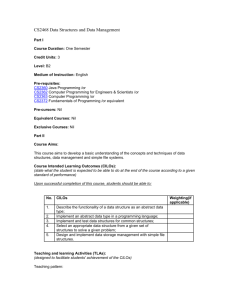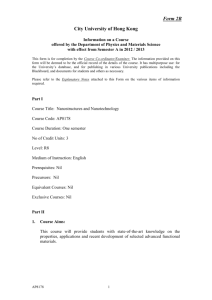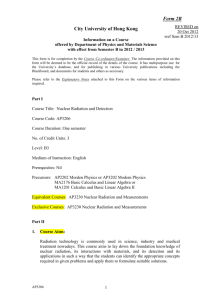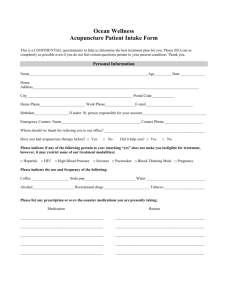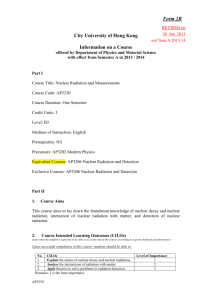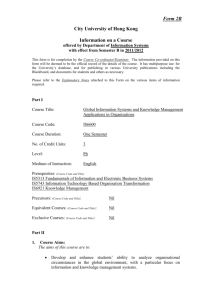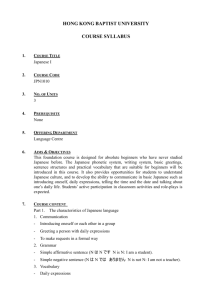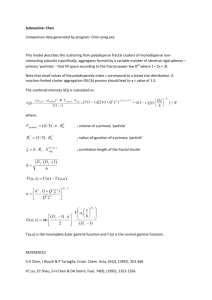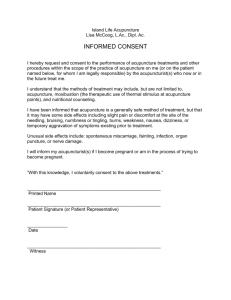- Hong Kong Baptist University
advertisement
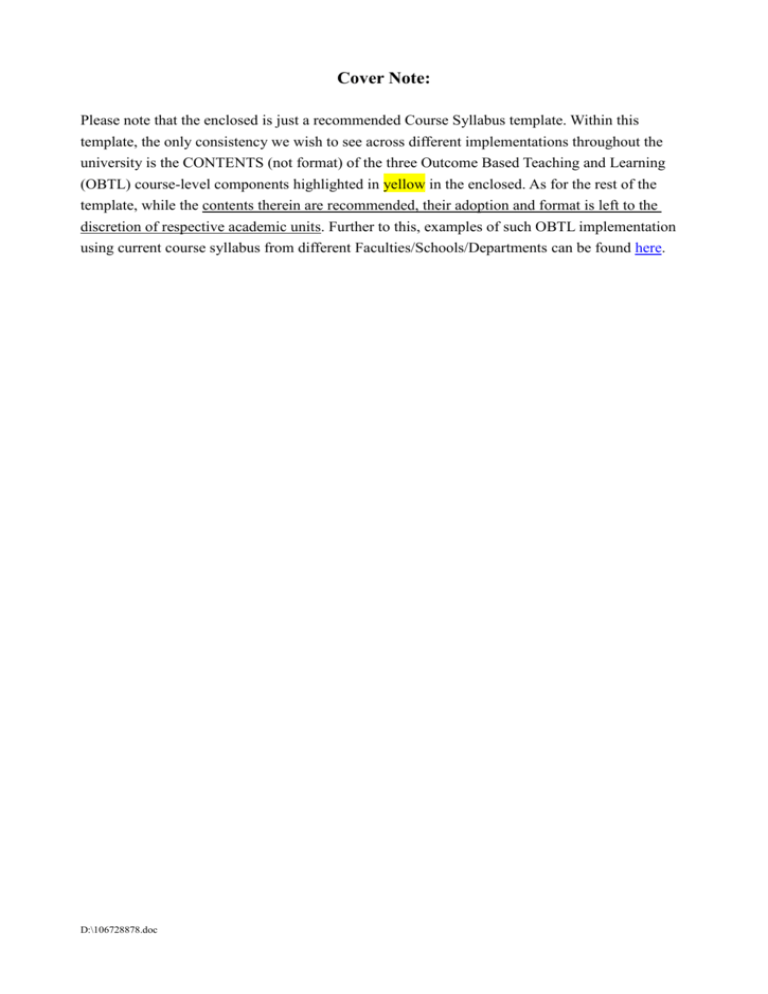
Cover Note: Please note that the enclosed is just a recommended Course Syllabus template. Within this template, the only consistency we wish to see across different implementations throughout the university is the CONTENTS (not format) of the three Outcome Based Teaching and Learning (OBTL) course-level components highlighted in yellow in the enclosed. As for the rest of the template, while the contents therein are recommended, their adoption and format is left to the discretion of respective academic units. Further to this, examples of such OBTL implementation using current course syllabus from different Faculties/Schools/Departments can be found here. D:\106728878.doc HONG KONG BAPTIST UNIVERSITY OUTCOME-BASED TEACHING & LEARNING (OBTL) SAMPLE TEMPLATE FOR COURSE SYLLABUS WITH EXPLANATORY NOTES & EXAMPLES Updated/AR & CHTL/March 2010/v2 1. COURSE TITLE 2. COURSE CODE 3. NO. OF UNITS 4. OFFERING DEPARTMENT 5. AIMS & OBJECTIVES Note: Aims and Objectives are more general than Learning Outcomes and they do not all need to be directly measurable (e.g. it would be all right to aim at ‘helping students to develop an awareness/understanding/appreciation of, or greater sensitivity/receptiveness to, something’ etc.). Objectives are specific intentions that indicate the steps to be taken to achieve our aims or goals as teachers. They indicate the teaching intentions and we can explain here the rationale for offering this course. 6. COURSE CONTENT Note: Here we provide a list of topics or themes or subject matter to be covered by the course. 7. COURSE INTENDED LEARNING OUTCOMES (CILOS) Note: CILOs are statements of what students are expected to be able to do as a result of studying this course. They are: expressed from the students' perspective, and in the form of action verbs leading to observable and assessable behaviour. It would be advisable not to have too many or too few CILO’s – 3 to 6 outcomes would (in most cases) be optimal, and they should ideally include outcomes pertaining to knowledge, cognitive skills as well as mental attitudes (these are not neatly divisible and an outcome may straddle more than one of them).The CILOs should state the levels of understanding the students are expected to achieve for the different content topics, and together they serve as a kind of ‘blueprint’ for D:\106728878.doc the teaching/learning activities and assessment methods. Also, ensure that the CILO’s are consistent with the programme outcomes as well as HKBU’s Graduate Attributes. For generic examples, please see enclosed Appendixes. Specific examples using current course syllabus from different Faculties/Schools/Departments can be found here. Help web references for action verbs: Bloom's taxonomy: http://www.casdk12.net/ghs04/SRB/5-Curriculum/Blooms%20Taxonomy%20chart.pdf http://www.nwlink.com/~Donclark/hrd/bloom.html SOLO's taxonomy: http://www.montclair.edu/academy/Documents/SOLO%20Taxonomy%20Developed%20by%20Joh n%20Biggs.pdf http://www.learningandteaching.info/learning/solo.htm 8. TEACHING & LEARNING ACTIVITIES (TLAS) Note: This is partly similar to the old heading ‘Teaching Methods’, but with more focus on what activities students have to do to learn. A brief statement like ‘lectures, tutorials, discussions’ is not sufficient here. This section is supposed to show (i) how the teacher intends to achieve the CILOs, through what kinds of learning activities, and (ii) how these T&L activities align with the CILOs. (This alignment with the CILOs is crucial as documented evidence where the learning of all the CILOs is facilitated.) For generic examples, please see enclosed Appendixes. Specific examples using current course syllabus from different Faculties/Schools/Departments can be found here. 9. ASSESSMENT METHODS (AMS) Note: It is not sufficient just to say ‘assignments, tests, final exam’. We need to furnish more concrete details about the nature of the assessments. AMs should be aligned with the appropriate CILOs to ensure that there is sufficient evidence to show that students have achieved the CILOs at the end of the course. (This alignment with the CILOs is crucial as documented evidence where the required competency of all the CILOs is assessed.) For generic examples, please see enclosed Appendixes. Specific examples using current course syllabus from different Faculties/Schools/Departments can be found here. D:\106728878.doc 10. TEXTBOOKS / RECOMMENDED READINGS Note: Try to provide a practical and realistic (rather than overly comprehensive) list of readings. Remember also to update your references regularly. D:\106728878.doc Appendix 1 – Examples for the completion of templates for course proposals To facilitate the completion of course templates for course proposals in OBTL format, the following shows some examples of CILOs – TLAs and CILOs – AMs alignment, as well as the actual activities that students are likely to be involved in during and outside of class. Example 1 – taken from language studies (for Template items 7 to 9 only) 7. CILO CILO 1 CILO 2 By the end of the course, students should be able to: Demonstrate an understanding of the nature of grammar Construct grammatical generalizations on the basis of empirical data 8. CILO No. CILO 1 TLAs The instructor will present concepts and theories on grammar and grammatical generalisations (or ‘rules’), and teach them how to use an electronic corpus to search for empirical evidence for the current state of grammar. Students will: CILO 2 discuss in class and explain to each other how grammatical ‘rules’ or generalizations are arrived at, using actual examples of their own from the databank, and critique arbitrary prescriptive rules of grammar which have no basis in empirical data. search an electronic English corpus for relevant data on particular grammatical constructions analyze the data for patterns and regularities and come up with appropriate generalizations of their own quizzes will help the students consolidate what they have learnt in the previous sessions 9. Type of Assessment Methods Quizzes Weighting Assignments 30% 1-2 Final examination 50% 1-2 In-class and on-line participation 10% (formative) 1-2 D:\106728878.doc 10% (formative) CILOs to be addressed 1-2 Description of Assessment Tasks Quizzes will test and reward students’ facility with concepts and cases from lectures and readings Assignments will test the students’ ability to search an electronic corpus for appropriate data on particular grammatical constructions, and come up with their own generalizations about these constructions, based on scientific grammatical principles. The examination will test the students’ ability to: evaluate the validity of a given grammatical rule with reference to empirical data, discover variations on a given grammatical construction, and determine the relative frequency, provenance, context of use and other notable features of each variant, identify and explain grammatical errors in a given text Class discussions and on-line discussions will encourage, reward, and assess students’ active contributions to analysis and their active engagement with other students Example 2 – taken from business (for Template items 7 to 9 only) 7. CILO CILO 1 CILO 2 By the end of the course, students should be able to: Demonstrate in-depth oral and written skills in the communication of financial reporting and related advice to clients and peers. Analyse and critically evaluate the financial performance of an organisation by demonstrating problem-solving and analytical skills in relation to complex financial reporting, external reporting and related business problems. 8. CILO No. CILO 1 TLAs The students will: be given a case study exercise in financial reporting and/or related advice to clients wherein each student will present both an oral and a written presentation of their respective answer to the class and the lecturer. be working in teams wherein each team will be given the annual financial report of a Hong Kong publicly listed organisation/company. The team is to critically analyse and evaluate the reported financial performance of said company based on their publicly available financial data and business reporting in the media. CILO 2 9. Type of Assessment Methods Quizzes Weighting Assignments 30% D:\106728878.doc 10% (formative) In the above exercise, the students will be guided on how to analyse and evaluate the relationship between reported business problems and their impact on the financial data of a given company. CILOs to be addressed 1-2 1-2 Description of Assessment Tasks Quizzes will test and reward the students’ understanding of financial reporting concepts and cases from lectures and readings. Assignments will test the students’ ability to apply the appropriate tools to analyse and evaluate the financial data reported in a company’s financial statement. The students’ will also be assessed on their ability to search and evaluate business reporting of companies in public archives, and to relate these to the financial performance of a company. The students’ reporting and written presentation skills in the communication of financial reporting and related advice to potential clients will also be assessed. Final examination 50% 1-2 The examination will test the students’ ability to: Analyse the financial performance of an organisation, Utilise different problem-solving skills to resolve and evaluate the performance of complex financial reports, Prepare financial statements for reporting to potential clients. In-class and on-line participation/presentation 10% (formative) 1-2 Class presentation and on-line discussion will assess and reward students’ oral presentation skills in the communication of financial reporting and related advice to potential clients. Furthermore, students’ active contribution to financial analysis and their active engagement with other students will also be assessed and rewarded. D:\106728878.doc Example 3 – taken from Chinese medicine (for Template items 7 to 9 only) 7. CILO CILO 1 By the end of the course, students should be able to: Demonstrate knowledge and understanding of the acupuncture meridian system by describing various acupuncture pathways and functions, and locate the 150 commonly used acupuncture points. Perform basic tonification and sedation acupuncture techniques to the commonly used acupuncture points, and to apply electro-acupuncture, plum blossom needle and moxibustion techniques. CILO 2 8. CILO No. CILO 1 TLAs The students will: be given hands-on instruction on how and where to locate the 150 commonly used acupuncture points using a acupuncture meridian system mannequin. be given hands-on instruction on drawing out the pathways of the acupuncture meridian system. be given written tasks to write out the functions of the acupuncture meridian system and relate these to the pathway of the same and their acupuncture points. be working in teams wherein each student in a team will be taught to apply electro-acupuncture, plum blossom needle and moxibustion on commonly used acupuncture points on a acupuncture meridian system mannequin. be given hand-on experience on how to perform tonification and sedation acupuncture techniques using a acupuncture meridian system mannequin. CILO 2 9. Type of Assessment Methods Midterm test Weighting 25% CILOs to be addressed 1-2 Final examination 75% 1-2 20% (formative) 1-2 Lab report participation D:\106728878.doc and class Description of Assessment Tasks This mid-semester written assessment aims to assess how well students have achieved their intended learning outcomes, so as to provide feedback for teachers and students alike. This systematic examination aims to assess the major learning outcomes achieved by students upon completion of the course. Students’ report of their laboratory practice will be marked and additional marks will be given to those who participated in acupuncture point location and needling demonstration actively to encourage their participation in laboratory practice. Example 4 – taken from visual arts (for Template items 7 to 9 only) 7. CILO CILO 1 CILO 2 By the end of the course, students should be able to: Critically evaluate old Chinese masterpieces to extract their intrinsic value and spirit. Create artworks through re-thinking skills and philosophy of traditional Chinese landscape painting. 8. CILO No. CILO 1 TLAs The students will: be given group sessions wherein students are required to provide critiques of well known Chinese masterpieces and each other’s assignment works. Attendance of these critique group sessions is compulsory and participation will be assessed. be involved in continuous hands-on studio work under the guidance of the instructor to apply the skills and philosophy of traditional Chinese landscape painting. submit 3 assignments and 1 final project throughout the semester wherein each student will be required to apply their interpretation of the skills and philosophy of traditional Chinese landscape painting. CILO 2 9. Type of Assessment Methods Continuous assessment of professional attitude (formative) Weighting 30% CILOs to be addressed 1-2 Assignments 40% 1-2 D:\106728878.doc Description of Assessment Tasks Evaluation is based on the continuous assessment of the student's performance. Since much of the work within this studio course relies on the interaction between students and instructor, it is impossible to maintain quality and assure a passing grade if classes are not attended on a regular basis. Attendance is required for the entire class period. Excessive tardiness will result in a lower grade. All assignments are assessed using the following criteria: originality (content), technical presentation and skill development (craftsmanship) and final design (formal design elements, the uses of brush and ink, and others). Since group critique is a constructive way of sharing ideas designed to help both individuals and the class as a whole to come up with new ideas and ways for art development, it coincides with the completion of assignments. Students are required to attend Final Project 30% 1-2 all scheduled critiques. Problem solving is also a very important part of the art making process. This final project will assess the cumulative skills set acquired by the student in this course. The student’s work on the Final Project will be assessed for: 1. Originality and problem solving; 2. Technical proficiency and visual presentation; 3. Over-all design or composition (expression of content and form), and 4. Creative re-thinking skills and philosophy of traditional Chinese landscape painting. Students critique groups will also provide critical assessments of the submitted works of the Final Project. D:\106728878.doc Example 5 – taken from mathematics (for Template items 7 to 9 only) 7. CILO CILO 1 CILO 2 By the end of the course, students should be able to: Able to understand the basic techniques in digital image enhancement and manipulate the software Matlab and its Image Processing Toolboxes. Able to understand and apply the theory of transform calculus for image analysis and image compression. 8. CILO No. CILO 1 TLAs The students will: be given group sessions wherein students are required to learn about a variety of digital image enhancement techniques and implement them in the software Matlab and its Image Processing Toolboxes. Attendance of these critique group sessions is compulsory and participation will be recorded. be taught the theory of transform calculus, especially in the context of image analysis and image compression. be applying different transform calculus techniques to analyse and compress different digital images. CILO 2 9. Type of Assessment Methods Test Weighting 20% CILOs to be addressed 1 Assignments 20% 1 Final Project 60% 1-2 D:\106728878.doc Description of Assessment Tasks The test is conducted in a computer lab to measure students' skills in solving image processing problems using the software Matlab and its image processing toolboxes. Assignments are designed to measure students understanding of the theory of digital image processing. Final Examination is designed to see how far students have achieved their intended learning outcomes especially in the Knowledge domain. Students should have a thorough understanding of the knowledge and apply them correctly in different context to do well in the exam.
